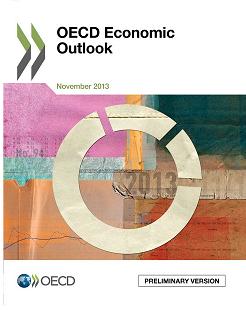OECD, (2013), OECD Economic Outlook, Vol. 2013/2, OECD Publishing.
Τhe global economy is expected to continue expanding at a moderate pace over the coming two years, but policymakers must ensure that instability in financial markets and underlying fragility in some major economies are not allowed to derail growth, according to the OECD’s latest Economic Outlook.
“The recovery is real, but at a slow speed, and there may be turbulence on the horizon,” OECD Secretary-General Angel Gurría said during the Outlook launch in Paris. “There is a risk of another bout of brinkmanship in the US, and there is also a risk that tapering of asset purchases by the US Federal Reserve could bring a renewed bout of instability. The exit from non-conventional monetary policy will be challenging, but so will action to prevent another flare-up in the euro area and to ensure that Japan’s growth prospects and fiscal targets are achieved,” Mr Gurría said.
GDP growth across the 34-member OECD is projected to accelerate from this year’s 1.2% rate to a 2.3% rate in 2014 and a 2.7% rate in 2015, according to the Outlook. The world economy, by contrast, will grow at a 2.7% rate this year, before accelerating to a 3.6% rate in 2014 and 3.9% in 2015. The pace of the global recovery is weaker than forecast last May, largely as a result of the worsened outlook for some emerging economies.
Growth in the United States is projected at a 2.9% rate in 2014 and a 3.4% rate in 2015. In Japan, GDP is expected to drop to a 1.5% growth rate in 2014 and a 1% rate in 2015. The euro area is expected to witness a gradual recovery, with growth of 1% in 2014 and 1.6% in 2015.
Growth has begun picking up in China but will remain weaker than previously projected in most other major emerging market economies. A group of emerging OECD member countries – Chile, Turkey, Mexico, Korea and Israel – will continue out-pacing growth in other advanced economies.
The Outlook draws attention to a range of downside risks in this recovery, which is still weak by past standards. It points to a worrisome slowdown in world trade growth, in foreign direct investment flows and in fixed investment, as well as continuation of stubbornly high unemployment, particularly in Europe, where it is only expected to fall below 12% by the end of 2015.
The OECD says US monetary policy should remain accommodative, while proposing a gradual winding down of asset purchases by the Federal Reserve, to limit impacts on vulnerable emerging-market economies. It calls for an end to fiscal deadlock in the United States, through the abolition of the nominal debt ceiling and implementation of a co-ordinated medium-term fiscal plan.
Welcoming the recent European Central Bank rate cut, the OECD said further easing may be required if deflation risks intensify. It called for rigorous implementation of the planned asset quality review and stress tests of euro area banks, followed by bank re-capitalisation, where needed, and further progress toward banking union.
Japan is encouraged to continue implementation of the so-called ‘’three arrows’’ of Abenomics, as part of the decisive action needed to exit deflation, put growth on a sustainable path, and meet the country’s long-term fiscal challenges.
“Growth since the global crisis has been uneven and hesitant, while job creation has been even more disappointing,” OECD Chief Economist Pier Carlo Padoan said during the Outlook presentation. “Clear and credible strategies are needed for how jobs and growth will be created and public finances restored. This will require a strong commitment to structural reforms in advanced and emerging market economies alike,” Mr Padoan said.




